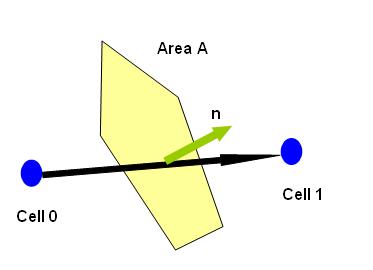Diffusion term
From CFD-Wiki
| Line 1: | Line 1: | ||
==Discretisation of Diffusive Term == | ==Discretisation of Diffusive Term == | ||
| - | === | + | === Description=== |
| - | + | <br> | |
| - | + | Note: The approaches those are discussed here are applicable to non-orthoganal meshes as well as orthogonal meshes. | |
| - | + | <br> | |
| - | + | ||
| - | + | ||
| - | + | ||
| - | + | ||
A control volume in mesh is made up of set of faces enclosing it. The figure 1.1 shows a typical situation. Where A represent the magnitude of area of the face. And n represents the normal unit vector of the face under consideration. | A control volume in mesh is made up of set of faces enclosing it. The figure 1.1 shows a typical situation. Where A represent the magnitude of area of the face. And n represents the normal unit vector of the face under consideration. | ||
<br> | <br> | ||
[[Image:Nm_descretisation_diffusionterms_01.jpg]] <br> | [[Image:Nm_descretisation_diffusionterms_01.jpg]] <br> | ||
'''Figure 1.1''' <br> | '''Figure 1.1''' <br> | ||
| + | :<br> | ||
<math> \vec r_{0} </math> and <math> \vec r_{1} </math> are position vector of centroids of cells cell 0 and cell 1 respectively. <br> | <math> \vec r_{0} </math> and <math> \vec r_{1} </math> are position vector of centroids of cells cell 0 and cell 1 respectively. <br> | ||
<math> {\rm{d\vec s}} = \vec r_{1} - \vec r_{0} </math> | <math> {\rm{d\vec s}} = \vec r_{1} - \vec r_{0} </math> | ||
| Line 20: | Line 17: | ||
| - | === | + | === Approach 1 === |
| + | Another approach is to use a simple expression for estimating the gradient of scalar normal to the face. <br> | ||
| + | :<math> | ||
| + | D_f = \Gamma _f \nabla \phi _f \bullet \vec A = \Gamma _f \left[ {\left( {\phi _1 - \phi _0 } \right)\left| {{{\vec A} \over {d\vec s}}} \right|} \right] | ||
| + | </math> <br> | ||
| + | where <math> \Gamma _f </math> is suitable face averages. <br> | ||
| + | |||
| + | This approach is not very good when the non-orthogonality of the faces increases. Instead for the fairly non-orthogonal meshes, it is advisable to use the following approaches. <br> | ||
| + | |||
| + | |||
| + | === Approach 2 === | ||
We define vector | We define vector | ||
<math> | <math> | ||
Revision as of 01:06, 15 September 2005
Contents |
Discretisation of Diffusive Term
Description
Note: The approaches those are discussed here are applicable to non-orthoganal meshes as well as orthogonal meshes.
A control volume in mesh is made up of set of faces enclosing it. The figure 1.1 shows a typical situation. Where A represent the magnitude of area of the face. And n represents the normal unit vector of the face under consideration.

Figure 1.1
 and
and  are position vector of centroids of cells cell 0 and cell 1 respectively.
are position vector of centroids of cells cell 0 and cell 1 respectively.

We wish to approaximate  at the face.
at the face.
Approach 1
Another approach is to use a simple expression for estimating the gradient of scalar normal to the face.
where  is suitable face averages.
is suitable face averages.
This approach is not very good when the non-orthogonality of the faces increases. Instead for the fairly non-orthogonal meshes, it is advisable to use the following approaches.
Approach 2
We define vector

giving us the expression:
where  and
and  are suitable face averages.
are suitable face averages.

![D_f = \Gamma _f \nabla \phi _f \bullet \vec A = \Gamma _f \left[ {\left( {\phi _1 - \phi _0 } \right)\left| {{{\vec A} \over {d\vec s}}} \right|} \right]](/W/images/math/e/b/a/eba7a8f962a26ccc4322e8e4cde187ee.png)
![D_f = \Gamma _f \nabla \phi _f \bullet {\rm{\vec A = }}\Gamma _{\rm{f}} \left[ {\left( {\phi _1 - \phi _0 } \right)\vec \alpha \bullet {\rm{\vec A + }}\bar \nabla \phi \bullet {\rm{\vec A - }}\left( {\bar \nabla \phi \bullet {\rm{d\vec s}}} \right)\vec \alpha \bullet {\rm{\vec A}}} \right]](/W/images/math/7/7/2/772b96059e9032fc07b25c0dee76db6c.png)